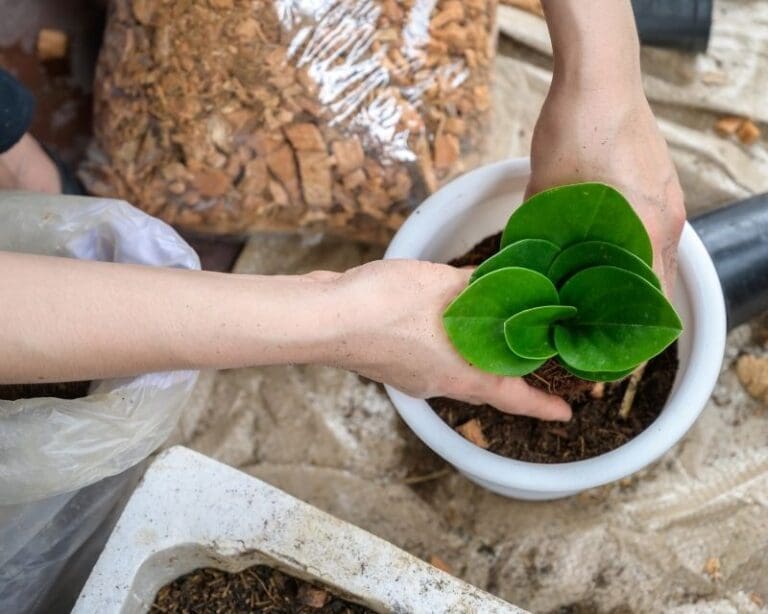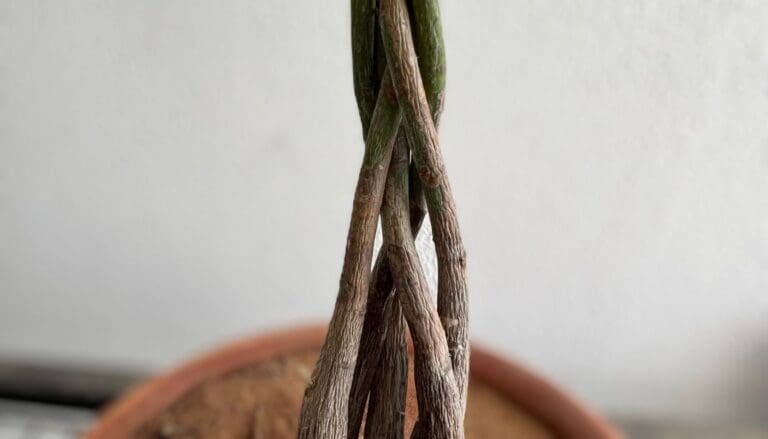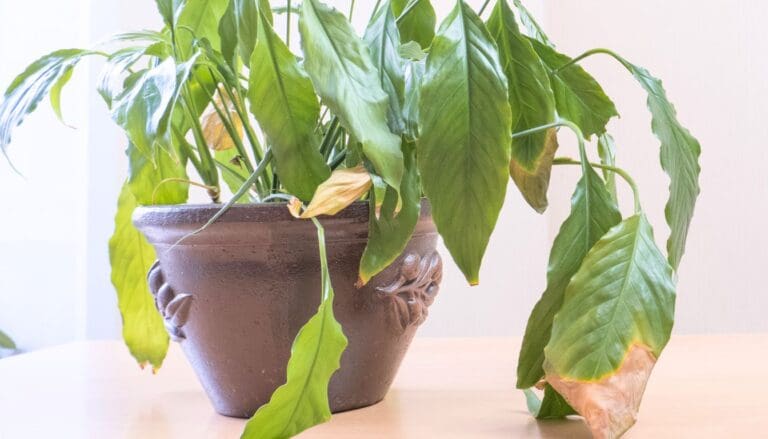Can I Put My Calathea Outside? (Crucial Points To Remember)
While speaking of Calathea, we always consider them as houseplants. They are mainly grown indoors and rarely grown outdoors.
So, a common question that comes to a plant owner’s mind is can I put my calathea outside?
Calatheas can be grown outdoors if you live in USDA zones 8 through 12 or any other place with a warm tropical climate. However, if the temperature drops below 55°F, you need to move them indoors. When kept outside, a spot with indirect sunlight away from cold drafts would be ideal for calathes.
If you want to take the chance of growing Calathea outside for a change, read this article to understand how you can grow and care for it outdoors.

Please note: Simplify Plants is reader-supported. Some links in the post are affiliate links and I get a commission from purchases made through links in the post.
Will Calathea grow outside?
The successful growth of Calathea outdoors depends on the region you live in and the way you provide them with their requirements. With proper planting and good care, it is possible to grow Calathea outside.
If you live in a warm region in the USDA plant hardiness zones 8 through 12, growing Calathea outdoors is not much problem.
There are other factors you need to consider while growing Calathea healthily outdoors.
Calathea should be provided with the same environment and cultural habits they used to receive in their native land. Calathea is habituated to grow under the canopies of the tropical rainforests.
So, Calathea will require bright filtered sunlight, high humid conditions, porous soil, and temperatures ranging from 65°F to 80°F. With such an ideal environment and growing conditions, maybe Calathea will grow successfully outdoors.
How to grow Calathea outside?
Now, let’s learn in what conditions Calathea would love to grow outdoors:
Location
When it comes to growing Calathea outdoors, the first thing you should consider is a perfect location in your garden. You need to choose a location where Calathea will not receive any direct sun rays.
Exposure to direct rays of the sun will scorch their beautiful, patterned leaves, causing sunburn.
The location you choose should save Calatheas from strong winds or chilling weather as these can reduce their surrounding temperatures.
You should ensure that the temperature around your Calathea doesn’t go below 60°F.
Calathea’s leaves tend to move upwards and downwards the whole day and close during the night. This movement depends on the light they’re receiving.
Calathea would move their leaves in the direction of the sunlight. So, while protecting them from the sun, do not entirely block the sun from reaching the plants.
In their native land, Calathea used to grow under the canopies. You can plant the Calathea in a location with a few tall trees and no tall buildings.
These trees can stop the direct sunlight from touching the Calathea leaves, and at the same time, they would help give the Calathea an ample amount of filtered sunlight.
If you’ve planted the Calatheas in an open site, you can create an artificial shelter with gardening nets to protect them from direct sun and give them filtered sun.
Also read: Where To Place Calathea Plant? (Factors To Consider+Ideal Placement)
Soil

When you choose to grow Calathea in the garden, you should opt for a kind of soil mixture that is light-weight, well-drained, and well-aerated. You should keep the soil moist consistently.
Do not overwater or under-water them. The pH level of the soil should remain around 6.5. This will provide them will an ideal growing condition.
Ensure the pot has proper drainage holes to flow out of the excess water from the pot after watering. You can also provide Calathea with a liquid fertilizer once a month, especially during the beginning of the spring, fall and summer.
Also read: What Kind Of Soil Is Best For Calathea? (Best Soil Mix For Calathea)
Choosing an ideal variety
There are many Calathea species available. You can choose any of them to grow outside.
But, as it is to be grown outside, choosing some beautifully patterned varieties can give your garden a unique look, along with your other plants.
I want to recommend some here:
- Calathea Ornata: Though they are known to be fussy, they have a beautiful dark shade of glossy green leaves, with white and pink colored pinstriping patterns. They are commonly called femme fatale.
- Calathea Zebrina: These have a different kind of pattern. Their leaves are ornamental, with bright green stripes all over them on a velvety dark green background, accompanied by rich colored purple markings under it. They are also known as zebra plants.
- Calathea Maykoana: This variety has purple color under the leaves and green and white marking on the surface of the leaves. They are also called peacock plants.
- Calathea crocata: This variety doesn’t have any patterns. Their leaves are plain, with metallic green outside and purple hues and brown underneath the leaves. But one thing is quite different in this variety than those mentioned above. They grow orange and red-colored flowers.
To enhance your garden with colors, you can try growing any of these Calathea varieties. There are other varieties too with different colors. You can also choose among them if you want.
Watering the Calathea

Watering Calatheas adequately is very important. You should water the Calatheas to keep them evenly moist but not soggy or waterlogged.
Water the Calatheas once a week to keep them moist. This routine might differ in different climatic conditions. Just check that the soil never remains dry for prolonged periods.
To identify watering issues in Calathea, see if the leaves show signs like brown or yellow leaves and dry and curly leaves. These are some signs indicating underwatering. So, deal with the watering properly.
Keep the soil moisture in check. Poke the finger inside the soil about 1 inch deep. When the soil feels dry, resume watering the plant again.
Also read: How Often To Water Calathea? (A Complete Calathea Watering Guide)
Temperature and humidity
Calatheas are tropical plants and won’t tolerate cold weather.
When your region receives too much cold, it can be unbearable for the Calatheas, and you need to protect them by constructing a cold frame or a grow tunnel.
The grow tunnel or cold frame will keep the Calatheas from receiving any harsh temperatures. This can also give your Calathea filtered sunlight.
But, at one point in time, the tunnel or frame needs to be removed. Then you’ll have to go back to that artificial shade for filtered sunlight.
The tunnel or frame will help the Calatheas receive their ideal humidity level inside it with evaporation.
These structures are removable. So whenever you find their need is over, you can remove them, especially when new foliage appears.
How to create a grow tunnel?
For creating grow tunnel on your own, you can use copper or PVC pipe. Bend them in an arch shape. Now, line up the arches in a row to create a tunnel and insert the arch ends into the ground.
Now take a 3-mil greenhouse grade plastic and use it to cover the arches. Use bricks, sandbags, pavers, or anything heavy to weigh down the plastic edges.
You can either form a low arch to cover the plants or a high arch to allow the plants to remain upright. If you have made low arches, you can keep open or cut 1-gallon milk cartons of water inside the tunnel every morning.
The use of milk cartons will create warm temperatures ideal for the plants.
It’ll create a stable temperature by absorbing the excess heat of the sun in the day and releasing the warmth at night. It will also help to increase the humidity levels in Calathea.
Also read: Should I Mist My Calathea Plant? (Calathea Humidity Requirements)
How to create a cold frame?
Use lumber or bales of hay to make a wall for a cold frame. Now, lay any old windows or glass shower doors across the hay or lumber top.
Inside the cold frames, you can use 1-gallon milk jugs to increase and stable the humidity and temperature, respectively.
These structures will help create suitable temperature and humidity; protect the plant from cold winters, heavy rains, harsh temperatures, or harmful external factors like strong wind or hail.
The milk cartons or jugs will also be responsible for the stable temperature and humidity inside the tunnel or frame.
Also read: What Temperature Can Calathea Tolerate? (Ideal Temperature Range)
Propagating Calathea for planting

If you already have a healthy matured Calathea indoors, you can propagate it by dividing from the mother plant to grow more plants and take them outdoors.
Check the following steps to propagate Calathea:
- Take the plant out of your pot carefully, without harming any healthy stems, leaves, or roots. If the plant doesn’t come out easily, tap the sides of the pot to loosen the soil.
- Remove the soil from the roots. Use fingers if needed.
- Watch out for the offshoots as the plant will grow from their middle sections.
- Now, time to divide. Separate the offshoots carefully. Prune the odd roots if they are stubborn. You can cut the plant a little if necessary. While separating, ensure that each plant section has enough root system.
- Relying on the size of the cutting and amount of matured roots, plant the section in soil mix or water. For example, if the roots need to grow more, you can place the section in water for some days and when the roots are grown, shift them into the soil.
- You can cover the plant with plastic to resemble a small greenhouse. Remove once the plant starts to grow.
How to care for Calathea outside?
Caring for Calathea is a little fussy. But with daily practice, you can quickly get familiar with all their primary care and needs. You’ll not feel any trouble caring for them.
- Water the Calathea to keep the soil moist. Watering once a week is enough. However, it may differ in different circumstances. For instance, when they thrive and take up all the water fast in the growing season, you need to water them more often to keep the soil moist.
- Avoid overwatering the Calathea. Or else, it will stop the Calatheas from closing at night and also trigger root rot.
- Add a 1-inch layer of mulch to help them absorb excess moisture, retain moisture and keep the soil temperature stable for Calatheas.
- During their growing season, if the growing conditions are excellent, they will require nutrients. You can fertilize Calathea 3-4 times throughout the growing season.
- Use a balanced fertilizer and water the plant well after fertilizing to help the nutrients spread evenly in the roots.
- When the growing season ends, and winter arrives, stop fertilizing. Cut watering frequency, nearly less than half compared to the growing season. Calathea will become dormant and stop growing in winter, and thus it won’t take up any nutrients or water.
- Maintain an ideal temperature and humidity. Don’t expose it to extreme temperatures or low humidity.
Some other tips for growing Calathea outdoors

1. Watch out for signs of color change in the leaves.
If there is any problem in the plant related to water, soil, fertilizer, temperature, or humidity, the leaves would be the first to show the signs. For example:
- The Calathea leaves will curl inwards if not watered enough. Resuming watering can bring back the leaves to normal.
- Yellow leaves or wilted leaves will be seen when you overwater them. Overwatering is quite difficult to treat compared to underwatering. So, in this case, prevention is the best way out.
- The plant’s base will become black and mushy if the soil is waterlogged. It indicates root rot. In worse conditions, you will have to transplant them.
- The brown spots are caused by sunburn. The patterns and colors will fade if exposed to direct sunlight. Protect them by creating shade.
- Brown spots are also signs of salt burn due to over-fertilization. Use less fertilizer if unsure.
- Brown spots circled with yellow haloes are signs of splashing water on leaves or some leaf spot disease. You should fix it as soon as possible.
- Another reason is tap water. Tap water contains hard minerals which are not suitable for Calathea. Use distilled or filtered water and rainwater for Calatheas.
- The leaf tips and edges will turn brown. These are signs of underwatering and low humidity. Water them well and maintain good humidity.
2. You should propagate only healthy and matured Calatheas. The tired or immature plants will not grow well.
3. Repot the Calathea when it goes rootbound. If you have kept the Calathea outside in a pot, you should repot it for providing enough space for the plant and root growth.
This can keep your Calathea strong and alive longer. For repotting, use a pot 1-2 inches wider in diameter than the current one and use new potting soil.
4. Protect the plant from pests and diseases. Outside, there are more chances of pests and diseases. The insects will hide primarily under the leaves.
Check out your plant regularly to watch any sight of pests or diseases. A stressed, damp plant is always attractive to pests and fungus. Avoid such situations.
Choose a bright spot for your plant, or you can shift your plant to a bright area if they’re in the pot.
You can use insecticidal soaps, dish wash, water solutions, or neem oil to protect Calatheas from pest and fungus infestation.
5. Take care of the leaves. The plants will be dustier outside than inside. So, you need to frequently clean the leaves.
Use leaf wipers or wet cloth to clean the leaves regularly. If the leaves get damp, clean them with paper napkins to dry up the leaves.
Instead of using any commercial leaf shiners, shower the plant with lukewarm water. But clean the leaves immediately with a soft cloth or paper towel.
Final words
Though houseplants, Calathea can be grown outside successfully if proper care is taken. You can grow Calatheas directly in your garden if you follow the perfect steps.
But, if you are not sure whether they can survive in garden soil or not, you can grow them in pots only. Just shift the container outside. Sometimes, garden soil contains clayey soil and can have different pH levels that would not be ideal for Calatheas.
By preparing the proper soil mix and creating perfect growing conditions like their native land, you can successfully grow Calatheas in a garden. They will give your garden a different look, along with the other plants you own.
Source: NCBI, University of Florida, Wikipedia, Growing Indoor Plants with Success, Agriculture, and Natural Resources, University of California, Missouri Botanical Garden.
Recommended Garden Supplies
| Product Image | Our Recommended Gardening Supplies | Check Offers! |
|---|---|---|
Top Top
Top
Top
Top
Top
Top
Top
Top | rePotme Houseplant and Tropical Classic Potting Soil Mix | Check Offer On Amazon |
 Top
Top
Top
Top
Top
Top
Top
Top | Espoma Organic Indoor Plant Food | Check Offer On Amazon |
 Top
Top
Top
Top
Top
Top
Top
Top | GooingTop LED Grow Light 6000K Full Spectrum Clip Plant Growing Lamp | Check Offer On Amazon |
 Top
Top
Top
Top
Top
Top
Top
Top | Soil Moisture Meter | Check Offer On Amazon |
 Top
Top
Top
Top
Top
Top
Top
Top | Govee Hygrometer Thermometer, Bluetooth Enabled! | Check Offer On Amazon |
 Top
Top | LEVOIT Humidifiers for Large Room(Best For Plants) | Check Offer On Amazon |
 Top
Top
Top
Top
Top
Top
Top
Top | Upgraded DIY Automatic Drip Irrigation Kit, 15 Potted Houseplants Support | Check Offer On Amazon |
 Top
Top
Top
Top
Top
Top
Top
Top | Stainless Steel Heavy Duty Gardening Tool Set | Check Offer On Amazon |
 Top
Top
Top
Top
Top
Top
Top
Top | Bonide Insecticidal Soap | Check Offer On Amazon |
 Top
Top
Top
Top
Top
Top
Top
Top | Bonide 32 oz Spray Neem Oil for Organic Gardening | Check Offer On Amazon |
 Top
Top
Top
Top
Top
Top
Top
Top | Garden Safe Fungicide | Check Offer On Amazon |






